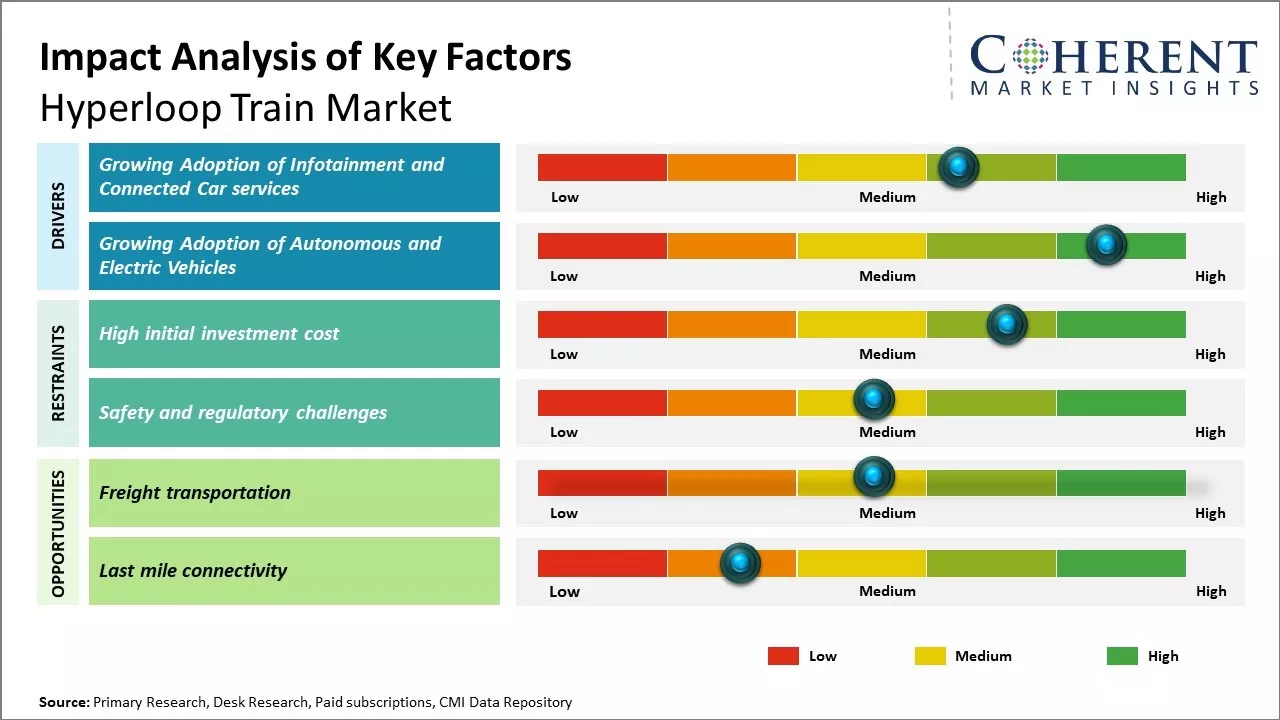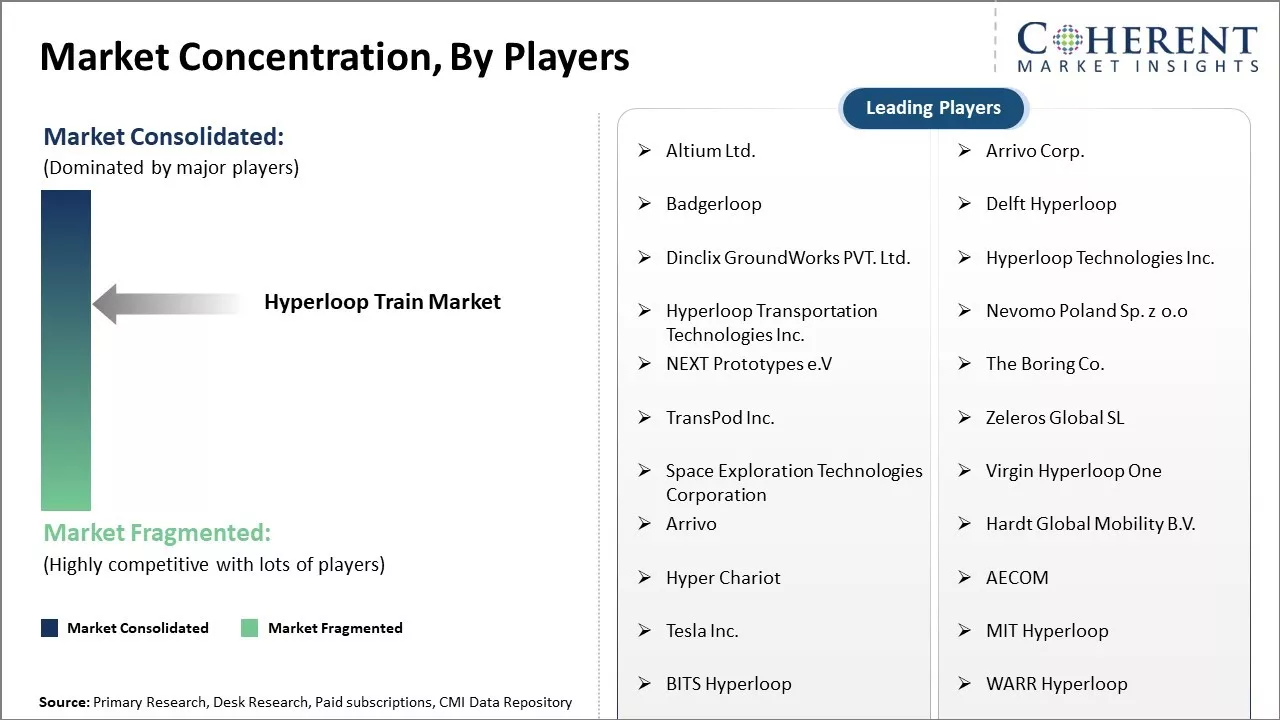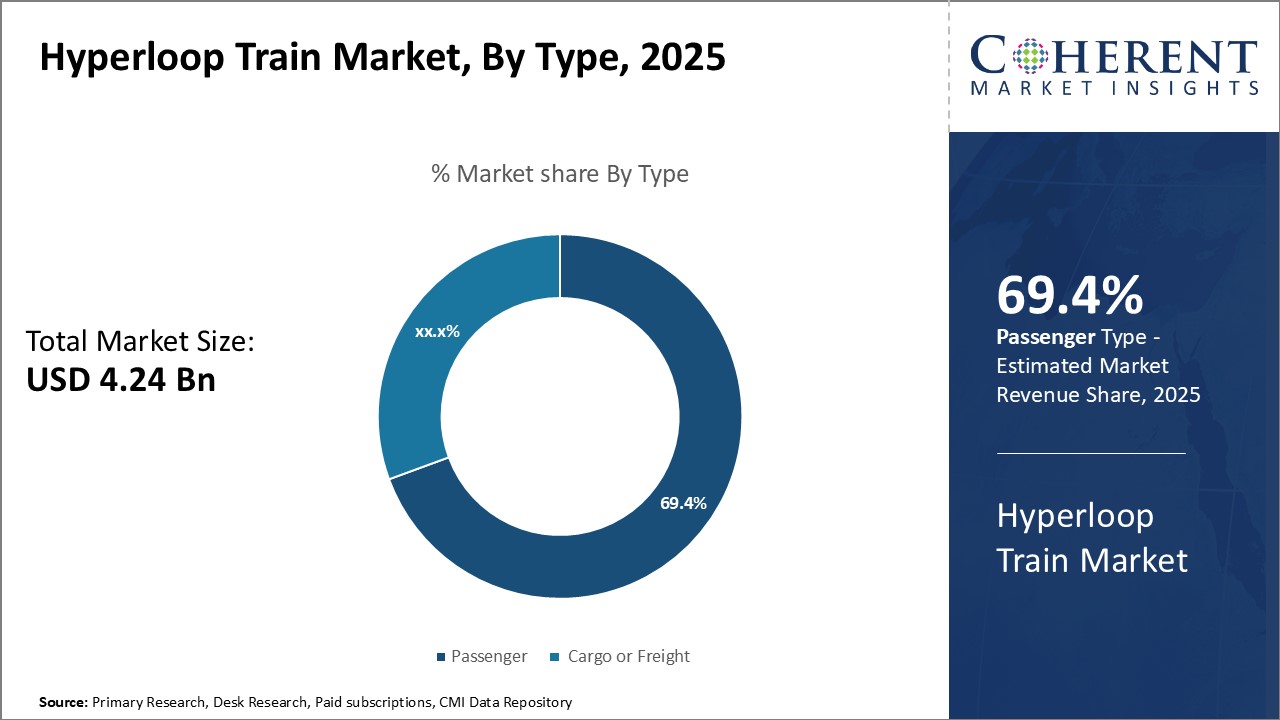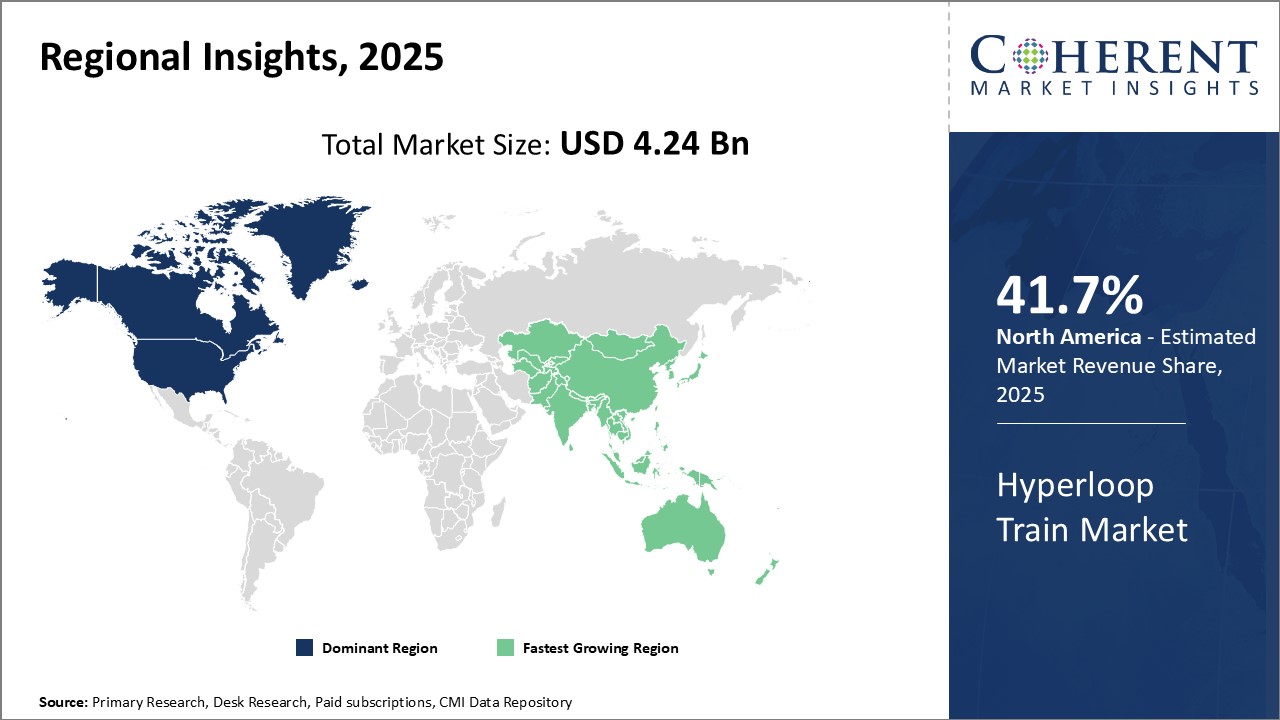Hyperloop Train Market Size and Trends
The hyperloop train market is estimated to be valued at USD 4.24 Bn in 2025 and is expected to reach USD 46.52 Bn by 2032, growing at a compound annual growth rate (CAGR) of 40.8% from 2025 to 2032.

Discover market dynamics shaping the industry: Download Free Sample
The hyperloop train market is expected to witness significant growth during the forecast period. The rising demand for sustainable modes of transportation coupled with growing investments by governments and key players in developing hyperloop projects are fueling the market growth. Hyperloop is seen as a revolutionary form of mass transportation that is more efficient and sustainable compared to existing high-speed rail and conventional transportation options. Additionally, hyperloop can help reduce commute times substantially while providing environment-friendly transportation. Key players like Virgin Hyperloop and Hyperloop Transportation Technologies are collaborating with several governments to build hyperloop networks, which is further enhancing the adoption of this technology.
Reducing Traffic Congestion
As populations increase and urbanization rises globally, traffic congestion has become a widespread problem affecting many major cities. Long commute times spent stuck in traffic jams negatively impact productivity and quality of life for many citizens. Hyperloop trains present an innovative solution that can help alleviate growing road traffic. By providing a fixed tube-based system traveling at over 600 miles per hour, hyperloops can transport far more passengers per hour than existing surface transportation methods like cars, buses and high-speed rail. This high-capacity mode of travel could absorb a significant portion of daily commuters, reducing the number of vehicles on congested roads and highways. For example, a hyperloop connection between two major population centers 30-50 miles apart could cut commute times down to less than 30 minutes, attracting many drivers to switch to this faster and more stress-free method of transportation. With its ability to move large volumes of people at much greater speeds than current transportation infrastructure allows, the hyperloop presents a way for cities to stay ahead of escalating traffic issues and sustain economic growth despite limited road capacity.
Market Concentration and Competitive Landscape

Get actionable strategies to beat competition: Download Free Sample
Environmental SustainabilityAs concerns grow about the environmental impacts of current transportation models, hyperloop technology presents an eco-friendly alternative powered largely by renewable energy. Hyperloop pods accelerate and glide through low-pressure tubes, requiring significantly less energy than electric planes, high-speed electric trains or electric vehicles to transport passengers or cargo over long distances. Tube networks could utilize solar panels installed along the lines to generate electricity, tapping into abundant natural energy sources. With their linear electric motors drawing power mainly from sustainable resources, hyperloops produce zero direct emissions. This makes them far less polluting than modes powered by fossil fuels which contribute heavily to greenhouse gas emissions and local air pollution. Hyperloops could facilitate greener transportation choices in densely populated economic corridors. By offering a fast, clean and affordable option for intercity travel, they may motivate more commuters and shippers to transition to zero-emissions transportation and help regions and industries meet ambitious environmental protection and sustainability goals.
Key Takeaways of Analyst:
The hyperloop train market is poised to be disruptive over the next decade. This new mode of transportation has the potential to revolutionize long-distance travel and unlock new economic opportunities across regions. While still in the early stages of development, the hyperloop concept shows promise as a faster and more sustainable alternative to existing high-speed rail and air travel.
The hyperloop technology reduces travel times drastically by operating pods or capsules through low-pressure tubes using magnetic levitation. This allows pods to reach aircraft-like speeds while using a small fraction of the energy consumed by plane travel. The viability of the hyperloop network depends on lowering construction costs to make projects economically feasible. Further decreasing tunneling expenses and ongoing maintenance through innovations in materials and design will be critical for the market's growth.
California has emerged as a frontrunner in hyperloop development and deployment. Virgin Hyperloop and other startups are making progress on certification milestones in the Golden State. However, regulatory certainty at the federal level will determine the timing of commercial operations. Meanwhile, countries across Europe, the Middle East, and Asia are ramping up feasibility studies to tap into the global hyperloop opportunity. As new routes are planned, corridor traffic analysis will influence investment decisions.
Market Challenges: High initial investment cost
One of the major challenges faced by the hyperloop train market is its massive infrastructure requirements. Developing tunnels through which hyperloop capsules can travel at near supersonic speeds requires substantial capital expenditure. Additional challenges include gaining necessary regulatory approvals since the technology is new and remains untested on a large commercial scale. Public safety concerns also exist around operating hyperloop systems and any technical failures pose risks that need to be carefully studied and addressed.
Market Opportunities: Freight transportation
The hyperloop train market offers significant opportunities for innovation and growth. As population increases further strain existing transportation networks, hyperloop technology presents an attractive solution to link major city hubs. Its ability to transport passengers and cargo at airline speeds through low-pressure tubes makes it highly competitive versus other modes. Success of hyperloop also opens up opportunities for developing supporting industries involving pod manufacturing, tunnel construction, operations and maintenance contracts.

Discover high revenue pocket segments and roadmap to it: Download Free Sample
Insights, By Type: Convenient and Affordable Travel Boosts Passenger SegmentIn terms of type, passenger contributes the highest share of the market owning 69.4% in 2025 to the growing demand for fast, affordable and convenient transportation options for medium distance travel. Hyperloop promises journey times that are significantly faster than other surface transportation modes like high-speed rail or road transport, while being more affordable and accessible than air travel. This makes it an attractive alternative for business and leisure travel across distances of 500-1,500 km. Compared to alternatives like airplanes that require airport check-ins and delays, hyperloop travel allows passengers to arrive at their destination center quickly after a hassle-free journey. The seating configuration inside hyperloop capsules is also designed for passenger comfort over longer durations. Further, as hyperloop routes get established between major city clusters globally, the ease of interconnected travel will propel the passenger traffic significantly.
Insights, By Component: Capsule Innovation Catalyzes Market Leadership of Component Segment
In terms of component, capsule contributes the highest share of the market owing 46.8% in 2025 given the primacy of innovation and technological advancement in capsule design. Heavy investments are being made by hyperloop companies as well as new startups to develop capsules with advanced life support systems, intelligent guidance and stabilization mechanisms, vibration dampening, emergency handling and customized passenger amenities. Safety and reliability being the top criteria for any hyperloop system, capsules require rigorous testing and certification. Continual performance enhancement of capsules through novel materials, engineering solutions and automated operations will be critical for gaining regulatory approvals and commercial operation. This drives sustained R&D into capsules, making it the locus of innovation and competition among hyperloop developers.
Insights, By Speed: Initial Market Potential Spurs Sub-700km/hr Systems Development
In terms of speed, Less Than 700 Km/Hr contributes the highest share of the market owing 69.9% in 2025 currently due to the initial potentials presented by shorter routes. While the eventual goal for hyperloop systems is high-subsonic speeds, initial technical and economic feasibility favors developing sub-700km/hr corridors that demonstrate operational viability. Routes less than 500km like those being planned in India and the Middle East provide a sizable addressable market to recover investment without requiring perfected very high-speed technologies. They also present comparatively lower construction challenges than longer tunnels. This makes shorter, slower loops an attractive starting point for commercialization given their near-term revenue potential. Establishing initial network connectivity through viable sub-700km/hr corridors will likely fuel further scaling up of the technology and entry into higher speed territories over the next decade.
Regional Insights

Need a Different Region or Segment? Download Free Sample
North America has emerged as the dominant region in the global hyperloop train market. The U.S. accounts for 41.7% of the total market share due to strong industry presence and continued government support for developing cutting-edge transportation infrastructure. Several major technology companies such as Virgin Hyperloop, Hyperloop Transportation Technologies, and TransPod are headquartered in the U.S. and are actively working with government agencies and private stakeholders on feasibility studies and pilot projects. States like Missouri, Texas, and Ohio have shown keen interest and finalized pre-construction contracts.
Moreover, the growing freight transportation sector is also driving the demand. Companies want to quickly transport goods over long distances at marginal costs. Hyperloop trains promise to revolutionize logistics with their high speeds and throughput capacities. This presents a massive business opportunity for hyperloop manufacturers and service providers. Major logistics players have partnered with hyperloop startups to explore how the technology can streamline their operations.
The Asia Pacific region has emerged as the fastest growing market for hyperloop trains. Countries like India and China are aggressively investing to develop hyperloop networks connecting their tier 1 and tier 2 cities. Both nations face severe congestion on existing transport infrastructure due to rapid urbanization and growing passenger traffic. Hyperloop represents a sustainable solution to decongest rail corridors and roads. Given their large landmasses, these countries can derive maximum benefit by implementing hyperloop systems for intercity travel.
India, in particular, has shown strong commitment by establishing the Hyperloop Development Council to foster public-private partnerships and draft regulations. The Council is collaborating with global leaders on conducting feasibility studies of 6 hyperloop projects. The government targets to start commercial operations by 2030 indicate growing appetite. Similarly, China has unveiled ambitious plans to deploy hyperloop systems across provinces as part of its high-speed transit vision. Both countries pose fertile ground for technology providers and constructors to establish manufacturing bases and after-sales networks. Their sizable spending power and policy initiatives will likely accelerate Asia Pacific's rise as the frontier of the hyperloop industry.
Market Report Scope
Hyperloop Train Market Report Coverage
| Report Coverage | Details | ||
|---|---|---|---|
| Base Year: | 2024 | Market Size in 2025: | USD 4.24 Bn |
| Historical Data for: | 2020 To 2024 | Forecast Period: | 2025 To 2032 |
| Forecast Period 2025 to 2032 CAGR: | 40.8% | 2032 Value Projection: | USD 46.52 Bn |
| Geographies covered: |
|
||
| Segments covered: |
|
||
| Companies covered: |
Altium Ltd., Arrivo Corp., Badgerloop, Delft Hyperloop, Dinclix GroundWorks PVT. Ltd., Hyperloop Technologies Inc., Hyperloop Transportation Technologies Inc., Nevomo Poland Sp. z o.o, NEXT Prototypes e.V, The Boring Co., TransPod Inc., Zeleros Global SL, Space Exploration Technologies Corporation, Virgin Hyperloop One, Arrivo, Hardt Global Mobility B.V., Hyper Chariot, AECOM, Tesla Inc., MIT Hyperloop, BITS Hyperloop, and WARR Hyperloop |
||
| Growth Drivers: |
|
||
| Restraints & Challenges: |
|
||
Uncover macros and micros vetted on 75+ parameters: Get instant access to report
Hyperloop Train Industry News
- In January 2024, ArcelorMittal announced a partnership with the Indian Institute of Technology Madras (IIT Madras) to boost hyperloop advancements, marking a significant step forward in improving fast transportation solutions in India and Asia. This collaboration involves two departments within IIT Madras: Avishkar Hyperloop and TuTr Hyperloop, a startup developed within the institute.
- In December 2022, Tata Steel and TuTr Hyperloop entered into an agreement to work together on advancing and implementing hyperloop technology. The research will focus on important aspects such as design intricacies and selecting suitable materials. The joint effort aims to develop, refine, and expand the technology's capabilities for market deployment. The initial phase of the project will take place on a 50-meter experimental track located at IIT Madras. Subsequent stages, Phase II and III, will involve building a 10-kilometer track and will include collaboration with additional industry partners from sectors like automotive, construction, and engineering.
- In March 2022, the U.K.-based company, Broughton Capital Group, in partnership with China-East Resources Import & Export Co. agreed in principle to provide a combined finance of USD 550 million and a Master EPC arrangement
- In October 2022, China made a big step in transportation innovation by successfully trying out its first hyperloop project. This test took place on a specially built 2 km long track in North China's Shanxi province. Before this, China had already shown its prowess with the maglev train, which reached speeds of 80 miles per hour. After the initial test went well, the team behind it announced plans to build a much longer test track, spanning 60 km and divided into three parts. Once completed, this track will allow trains to be tested at speeds of up to 621 miles per hour.
*Definition: The hyperloop train is an innovative transportation system that uses magnetism to move pods through low-pressure tubes at airplane speeds on the ground. Passengers or cargo are loaded into the pods which accelerate gradually via electric propulsion through magnetic fields to top speeds exceeding 600 mph. The pods float above the track using magnetic levitation and glide nearly effortlessly with very low amounts of friction and air resistance.
Market Segmentation
- Type Insights (Revenue, USD BN, 2020 - 2032)
- Passenger
- Cargo or Freight
- Component Insights (Revenue, USD BN, 2020 - 2032)
- Capsule
- Tube and Propulsion system
- Route
- Speed Insights (Revenue, USD BN, 2020 - 2032)
- Less Than 700 Km/Hr
- More Than 700 Km/Hr
- Regional Insights (Revenue, USD BN, 2020 - 2032)
- North America
- U.S.
- Canada
- Latin America
- Brazil
- Argentina
- Mexico
- Rest of Latin America
- Europe
- Germany
- U.K.
- France
- Italy
- Russia
- Rest of Europe
- Asia Pacific
- China
- India
- Japan
- Australia
- South Korea
- ASEAN
- Rest of Asia Pacific
- Middle East & Africa
- GCC Countries
- South Africa
- Rest of Middle East & Africa
- North America
- Key Players Insights
- Altium Ltd.
- Arrivo Corp.
- Badgerloop
- Delft Hyperloop
- Dinclix GroundWorks PVT. Ltd.
- Hyperloop Technologies Inc.
- Hyperloop Transportation Technologies Inc.
- Nevomo Poland Sp. z o.o
- NEXT Prototypes e.V
- The Boring Co.
- TransPod Inc.
- Zeleros Global SL
- Space Exploration Technologies Corporation
- Virgin Hyperloop One
- Arrivo
- Hardt Global Mobility B.V.
- Hyper Chariot
- AECOM
- Tesla Inc.
- MIT Hyperloop
- BITS Hyperloop
- WARR Hyperloop
Share
Share
About Author
Ameya Thakkar is a seasoned management consultant with 9+ years of experience optimizing operations and driving growth for companies in the automotive and transportation sector. As a senior consultant at CMI, Ameya has led strategic initiatives that have delivered over $50M in cost savings and revenue gains for clients. Ameya specializes in supply chain optimization, process re-engineering, and identification of deep revenue pockets. He has deep expertise in the automotive industry, having worked with major OEMs and suppliers on complex challenges such as supplier analysis, demand analysis, competitive analysis, and Industry 4.0 implementation.
Missing comfort of reading report in your local language? Find your preferred language :
Transform your Strategy with Exclusive Trending Reports :
Frequently Asked Questions
EXISTING CLIENTELE
Joining thousands of companies around the world committed to making the Excellent Business Solutions.
View All Our Clients

